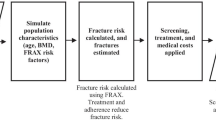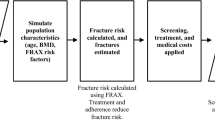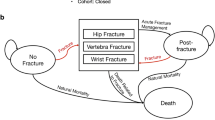Abstract
Summary
Annual osteoporotic fractures is projected to increase by 135% from 6.9 M (2020) to 16.2 M (2040), increasing the economic burden by 121% from $29.9B (2020) to $65.9B (2040).
Introduction
Globally, aging populations drive significant increases in osteoporosis prevalence. In China, the number of women aged ≥ 65 years is expected to more than double from 2020 (91.5 M) to 2040 (183.6 M). Using a microsimulation model, impact of increased diagnosis and treatment of postmenopausal women (PMW) with osteoporosis on anticipated reduction in fractures and associated costs in China from 2020 to 2040 was projected.
Methods
A microsimulation model was developed to project annual incidence and costs of osteoporotic fractures among PMW in China from 2020 to 2040. Fracture risk was estimated using the simplified Fracture Risk Assessment Tool (FRAX). Fractures estimates were based on annualized FRAX risk and impact of treatment. Published literature informed inputs for direct and indirect fracture costs, DXA screening costs, and treatment costs and efficacy. China’s current screening and treatment rates were compared against 50% increases to (i) case finding (screening rate and subsequent treatment rate) and (ii) treatment rate among those at highest fracture risk.
Results
From 2020 to 2040, 241.7 M osteoporotic fractures are projected to cost $997B. Increased treatment scenario prevented 24.6 M fractures and saved $56B. Increased case finding scenario prevented 26 M fractures and saved $61.7B.
Conclusion
Osteoporosis underdiagnosis and undertreatment among the aging Chinese population will considerably burden patients, caregivers, and society. Policy changes to increase screening and treatment rates may result in significant cost savings and clinical benefits.



Similar content being viewed by others
References
Sandhu SK, Hampson G (2011) The pathogenesis, diagnosis, investigation and management of osteoporosis. J Clin Pathol 64(12):1042–1050
Wang J, Wang Y, Liu WD, Wang F, Yin ZS (2014) Hip fractures in Hefei, China: the Hefei osteoporosis project. J Bone Miner Metab 32(2):206–214
UN World Population Prospects (2019) Available from https://population.un.org/wpp/DataQuery/. Accessed 18 Aug 2020
Liu ZH, Zhao YL, Ding GZ, Zhou Y (1997) Epidemiology of primary osteoporosis in China. Osteoporos Int 7 Suppl 3:S84–S87
Si L, Winzenberg TM, Chen M, Jiang Q, Palmer AJ (2015) Residual lifetime and 10 year absolute risks of osteoporotic fractures in Chinese men and women. Curr Med Res Opin 31(6):1149–1156
Si L, Winzenberg TM, Jiang Q, Chen M, Palmer AJ (2015) Projection of osteoporosis-related fractures and costs in China: 2010–2050. Osteoporos Int 26(7):1929–1937
Wang O, Hu Y, Gong S, Xue Q, Deng Z, Wang L, Liu H, Tang H, Guo X, Chen J, Jia X, Xu Y, Lan L, Lei C, Dong H, Yuan G, Fu Q, Wei Y, Xia W, Xu L (2015) A survey of outcomes and management of patients post fragility fractures in China. Osteoporos Int 26(11):2631–2640
Xie Z, Burge R, Yang Y, Du F, Lu T, Huang Q, Ye W, Xu W (2015) Posthospital discharge medical care costs and family burden associated with osteoporotic fracture patients in China from 2011 to 2013. J Osteoporos 2015:258089
Ma L, Li Y, Wang J, Zhu H, Yang W, Cao R, Qian Y, Feng M (2015) Quality of life is related to social support in elderly osteoporosis patients in a Chinese population. PLoS ONE 10(6):e0127849. https://doi.org/10.1371/journal.pone.0127849
Qu B, Ma Y, Yan M, Wu HH, Fan L, Liao DF, Pan XM, Hong Z (2014) The economic burden of fracture patients with osteoporosis in western China. Osteoporos Int 25(7):1853–1860
International Osteoporosis Foundation. The Asia-Pacific Regional Audit - epidemiology, costs and burden of osteoporosis in 2013. https://www.osteoporosis.foundation/sites/iofbonehealth/files/2019-06/2013_Asia_Pacific_Audit_English.pdf. Accessed 15 Sept 2020
Kung AW, Fan T, Xu L, Xia WB, Park IH, Kim HS, Chan SP, Lee JK, Koh L, Soong YK, Soontrapa S, Songpatanasilp T, Turajane T, Yates M, Sen S (2013) Factors influencing diagnosis and treatment of osteoporosis after a fragility fracture among postmenopausal women in Asian countries: a retrospective study. BMC Womens Health 13:7
Cheung EYN, Tan KCB, Cheung CL, Kung AWC (2016) Osteoporosis in East Asia: current issues in assessment and management. Osteoporos Sarcopenia 2(3):118–133
Chen P, Li Z, Hu Y (2016) Prevalence of osteoporosis in China: a meta-analysis and systematic review. BMC Public Health 16(1):1039
Centre for Metabolic Bone Diseases, University of Sheffield, UK. FRAX® Fracture Risk Assessment Tool. [cited 13 Sept 2020]. Available from https://www.sheffield.ac.uk/FRAX/. Accessed 13 Sept 2020
Wang J, Wang X, Fang Z, Lu N, Han L (2017) The effect of FRAX on the prediction of osteoporotic fractures in urban middle-aged and elderly healthy Chinese adults. Clinics (Sao Paulo) 72(5):289–293
Cheng XG, Yang DZ, Zhou Q, Zhuo TJ, Zhang HC, Xiang J, Wang HF, Ou PZ, Liu JL, Xu L, Huang GY, Huang QR, Barden HS, Weynand LS, Faulkner KG, Meng XW (2007) Age-related bone mineral density, bone loss rate, prevalence of osteoporosis, and reference database of women at multiple centers in China. J Clin Densitom 10(3):276–284
Zhou H et al (2016) A community-based study of osteoporosis-related information in Chinese female residents aged 40 years and older. Int J Clin Exp Med 9(12):23506–23512
Chen Y Investigation on the persistence and compliance of bisphosphonates in patients with osteoporosis. http://cdmd.cnki.com.cn/Article/CDMD-10026-1016069171.htm. Accessed 25 April 2021. 2016
Cheng TT, Yu SF, Hsu CY, Chen SH, Su BY, Yang TS (2013) Differences in adherence to osteoporosis regimens: a 2-year analysis of a population treated under specific guidelines. Clin Ther 35(7):1005–1015
Cui L, He T, Jiang Y, Li M, Wang O, Jiajue R, Chi Y, Xu Q, Xing X, Xia W (2020) Predicting the intervention threshold for initiating osteoporosis treatment among postmenopausal women in China: a cost-effectiveness analysis based on real-world data. Osteoporos Int 31(2):307–316
Chan DC, Chang CH, Lim LC, Brnabic AJM, Tsauo JY, Burge R, Hsiao FY, Jin L, Gürbüz S, Yang RS (2016) Association between teriparatide treatment persistence and adherence, and fracture incidence in Taiwan: analysis using the National Health Insurance Research Database. Osteoporos Int 27(9):2855–2865
Freemantle N, Cooper C, Diez-Perez A, Gitlin M, Radcliffe H, Shepherd S, Roux C (2013) Results of indirect and mixed treatment comparison of fracture efficacy for osteoporosis treatments: a meta-analysis. Osteoporos Int 24(1):209–217
Barrionuevo P, Kapoor E, Asi N, Alahdab F, Mohammed K, Benkhadra K, Almasri J, Farah W, Sarigianni M, Muthusamy K, Al Nofal A, Haydour Q, Wang Z, Murad MH (2019) Efficacy of pharmacological therapies for the prevention of fractures in postmenopausal women: a network meta-analysis. J Clin Endocrinol Metab 104(5):1623–1630
Pike CT, Birnbaum HG, Schiller M, Swallow E, Burge RT, Edgell ET (2011) Prevalence and costs of osteoporotic patients with subsequent non-vertebral fractures in the US. Osteoporos Int 22(10):2611–2621
Weaver J, Sajjan S, Lewiecki EM, Harris ST, Marvos P (2017) Prevalence and cost of subsequent fractures among U.S. patients with an incident fracture. J Manag Care Spec Pharm 23(4):461–471
Choi SH, Kim DY, Koo JW, Lee SG, Jeong SY, Kang CN (2020) Incidence and management trends of osteoporotic vertebral compression fractures in South Korea: a nationwide population-based study. Asian Spine J 14(2):220–228
King AB, Saag KG, Burge RT, Pisu M, Goel N (2005) Fracture Reduction Affects Medicare Economics (FRAME): impact of increased osteoporosis diagnosis and treatment. Osteoporos Int 16(12):1545–1557
Laliberté MC, Perreault S, Dragomir A, Goudreau J, Rodrigues I, Blais L, Damestoy N, Corbeil D, Lalonde L (2010) Impact of a primary care physician workshop on osteoporosis medical practices. Osteoporos Int 21(9):1471–1485
Majumdar SR, Johnson JA, McAlister FA, Bellerose D, Russell AS, Hanley DA, Morrish DW, Maksymowych WP, Rowe BH (2008) Multifaceted intervention to improve diagnosis and treatment of osteoporosis in patients with recent wrist fracture: a randomized controlled trial. CMAJ 178(5):569–575
Cranney A, Wells GA, Yetisir E, Adami S, Cooper C, Delmas PD, Miller PD, Papapoulos S, Reginster JY, Sambrook PN, Silverman S, Siris E, Adachi JD (2009) Ibandronate for the prevention of nonvertebral fractures: a pooled analysis of individual patient data. Osteoporos Int 20(2):291–297
Lewiecki EM, Ortendahl JD, Vanderpuye-Orgle J, Grauer A, Arellano J, Lemay J, Harmon AL, Broder MS, Singer AJ (2019) Healthcare policy changes in osteoporosis can improve outcomes and reduce costs in the United States. JBMR Plus 3(9):e10192
Burge R, Dawson-Hughes B, Solomon DH, Wong JB, King A, Tosteson A (2007) Incidence and economic burden of osteoporosis-related fractures in the United States, 2005–2025. J Bone Miner Res 22(3):465–475
Konnopka A, Jerusel N, König HH (2009) The health and economic consequences of osteopenia- and osteoporosis-attributable hip fractures in Germany: estimation for 2002 and projection until 2050. Osteoporos Int 20(7):1117–1129
Funding
This study was funded by Amgen.
Author information
Authors and Affiliations
Contributions
Study design: MG, MJ, and ZW. Study conduct: MG, MJ, and ZW. Data collection: MG, MJ, Man Yee (Mallory) Leung, and ZW. Data analysis: MG, MJ, and ZW. Data interpretation: MJ and ZW. Drafting of the manuscript: LC, MG, MJ, WX, and ZW with writing support from Kaushik Sarikonda and November McGarvey, employees of BluePath Solutions. Revising the manuscript: LC, MG, MJ, WX, and ZW. Approving the final version of the manuscript: LC, MG, MJ, WX, and ZW. MG, MJ, and ZW take responsibility for the integrity of the data analysis.
Corresponding authors
Ethics declarations
Conflict of interest
MG and MJ are employees of BluePath Solutions which has received funding from Amgen for this project. ZW is an employee of Amgen and owns stock in Amgen. LC and WX have nothing to disclose.
Additional information
Publisher’s note
Springer Nature remains neutral with regard to jurisdictional claims in published maps and institutional affiliations.
Rights and permissions
About this article
Cite this article
Cui, L., Jackson, M., Wessler, Z. et al. Estimating the future clinical and economic benefits of improving osteoporosis diagnosis and treatment among women in China: a simulation projection model from 2020 to 2040 . Arch Osteoporos 16, 118 (2021). https://doi.org/10.1007/s11657-021-00958-x
Received:
Accepted:
Published:
DOI: https://doi.org/10.1007/s11657-021-00958-x




